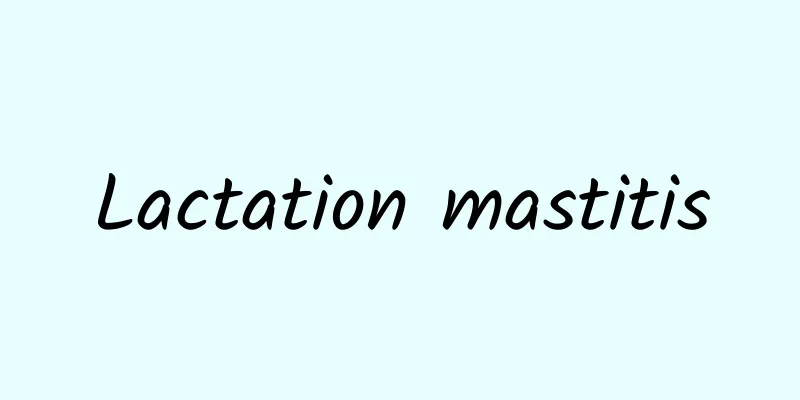Lactation mastitis

|
This is the 3896th article of Da Yi Xiao Hu Lactational mastitis is a common disease among breastfeeding mothers. The WHO defines it as: an inflammatory reaction of the breast caused by milk congestion or infection during lactation, which may or may not be accompanied by bacterial infection, with or without redness, swelling, heat, and pain in the breast area, and may be accompanied by fever, chills, flu-like symptoms, and other general discomfort. Lactational mastitis often occurs in the first two months after delivery. It often recurs, is difficult to heal, and may even develop into breast abscess. There are misunderstandings in the treatment of lactational mastitis, such as the abuse of antibiotics and premature cessation of breastfeeding, which have a certain impact on the physical and mental health of lactating mothers and the growth and development of their children. Causes of mastitis during lactation The main causes of lactation mastitis are milk stasis, nipple rupture leading to bacterial infection and poor body resistance after childbirth. The causes of milk stasis include congenital nipple dysplasia, too little sucking by the baby, excessive milk secretion, fear of pain, and milk stasis caused by excessive lactation. Nipple rupture is mainly caused by improper feeding, baby biting, etc., which form open wounds, allowing bacteria to enter and multiply, leading to lactation mastitis. Poor local hygiene of the nipple is also an important cause. Symptoms of mastitis during lactation Clinically, breastfeeding mastitis is mainly divided into two types: milk stasis type and acute breast inflammation type. The milk stasis type is characterized by local swelling, pain, and induration of the breast, with no obvious increase in skin temperature. Mothers do not have inflammatory symptoms such as fever and chills, and blood routine tests are generally normal. The acute breast inflammation type is characterized by local redness, swelling, heat, and pain of the breast, accompanied by systemic fever, and blood routine tests generally show an increase in white blood cell and neutrophil counts and C-reactive protein. Treatment of mastitis during lactation For lactation mastitis, the main treatment method is auxiliary milk ejection plus antibiotics. For patients with milk stasis, we can use standardized manual milk ejection or electric milk drainage treatment, assisted by local breast medication. For acute inflammation, in addition to milk ejection, antibiotic treatment is required. During the entire treatment period, try to avoid eating to induce lactation, and a light diet is recommended to keep the local nipple clean. Ensure that the mother has adequate rest, and appropriately replenish fluids, use painkillers, and provide psychological counseling. Use of antibiotics The antibiotics that can be used for acute breast inflammation during lactation are penicillin or cephalosporin antibiotics. However, since some of the accumulated antibiotics in the body of lactating women will enter the breast milk, it may affect the number of probiotics in the infant's intestines. When using these two types of antibiotics, the infant should be observed for diarrhea symptoms. If severe diarrhea occurs, breastfeeding should be stopped or other types of antibiotics should be used instead. Antibiotics that are strictly prohibited for use during breastfeeding include tetracycline, ciprofloxacin, and chloramphenicol. Once used, breastfeeding should be stopped immediately. In rare cases, the inflammation involves the entire breast. At this time, milk should be weaned and breastfeeding should be stopped in order to better control the infection. If an abscess is formed, incision or puncture drainage should be considered. If I have mastitis during lactation, can I continue breastfeeding? Regardless of whether it is lactational mastitis, as long as no breast abscess is formed, the patient should be encouraged to continue breastfeeding on the affected side during the treatment process, and feeding on the healthy side will not be affected. Studies have shown that continuing to feed during lactational mastitis will not only not cause health damage to the baby and the mother, but will also help the health of the baby and the mother, because the types and numbers of immune cells and cytokines in the breast milk of patients with lactational mastitis have increased. Such changes not only help the mother's own resistance to breast infection, but also help activate the baby's immune system. If feeding is difficult due to the wound on the breast, or the baby's sucking cannot relieve breast symptoms at all, or there is an excessive worry that continuing to feed will cause the baby to be infected, you can also choose to manually express milk or use a breast pump to express milk to maintain milk secretion. Mastitis during lactation often occurs. Young mothers should face it with a positive and optimistic attitude, identify breast changes in time, seek medical attention as soon as possible, and take appropriate measures. In addition, in the process of treating mastitis during lactation, follow the doctor's instructions and use individualized treatment. This will not only not affect your own health and the health of your baby, but also allow you to continue breastfeeding scientifically while promoting the recovery of your own breasts, avoiding fear of breastfeeding and inappropriate cessation of breastfeeding. Author: Huang Luyao Qian Mingping |
<<: Can anger really make one blind? After a quarrel with someone, she almost went blind...
>>: Lifestyle changes and drug treatment for dyslipidemia
Recommend
How to nourish the kidneys for damp-heat constitution, these foods cannot be missed
Damp-heat constitution is one of the nine constit...
Can I eat fruit during confinement in summer?
Fruit is a must in people’s daily diet because it...
What to do if you have diarrhea during ovulation promotion
There are many reasons for diarrhea now, and most...
How to regulate after spontaneous abortion
Abortion is very harmful to women's health. A...
Why do car tires make noises when turning? What is the problem when car tires make noises when turning in winter?
Because of the tread pattern, the tire can grip t...
What is the white liquid in the lower body?
A woman's lower body will secrete white fluid...
I feel pregnant and my period has come again
When a woman's sexual organs and reproductive...
Is sleepwalking a dream? Why do we sleepwalk while we are asleep?
When it comes to sleepwalking, you might think of...
Can taking folic acid help you conceive twins?
Women who want to get pregnant often have a beaut...
In the golden period of spring, three methods can help children grow taller
With the arrival of spring, the body's metabo...
How to take care of your breasts
Loving beauty is women's nature, and women al...
How to supplement iron deficiency in late pregnancy
Iron deficiency in the late pregnancy is more ser...
How long does it take for body temperature to rise after ovulation?
During a woman's ovulation period, her basal ...
How can female friends improve the immunity of their cervix?
The accelerated pace of life today has increased ...
How to prevent breast cancer?
How to prevent breast cancer? In addition to exam...









